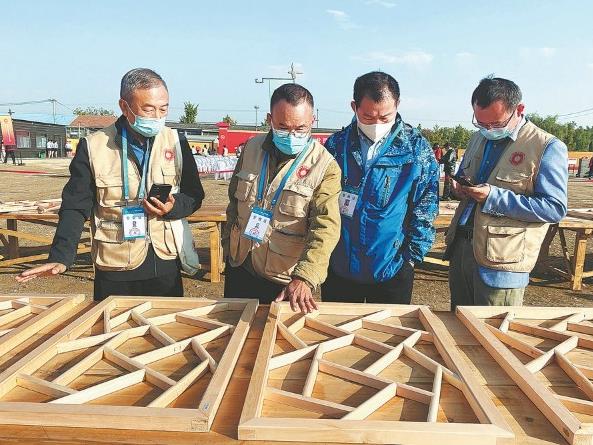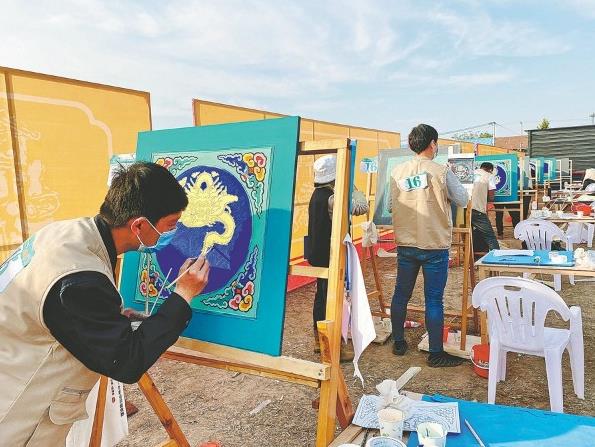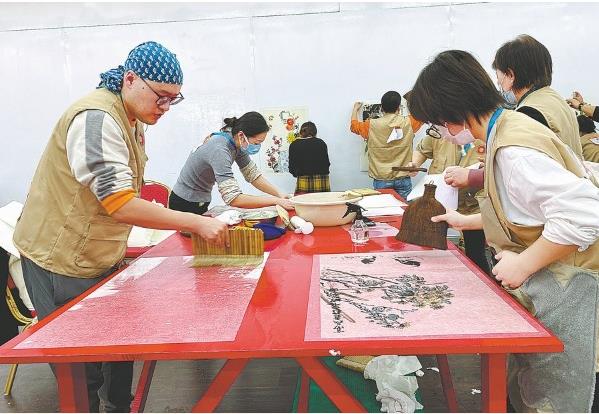Event helps keep ancient decorative expertise alive
By Zhao Ruixue| (China Daily)| Updated : 2021-11-02
Print Print
People exchange views on the cracked-ice pattern window frames made by competitors of the carpentry group at the vocational skill competition. [Photo by Zhao Ruixue/China Daily]
Even though it was autumn, the sun was harsh at an outdoor ground where more than 150 people from 19 provinces and regions were competing in a vocational skill competition on artifacts in Qufu, Shandong province, on Oct 22. Their task was to finish a given work related to artifacts within six hours.
Zheng Jianyang, along with 19 people, started at 9:30 am drawing on a square woodblock a twisted dragon, a typical decorative color painting used in wooden architecture in previous centuries.
The 34-year-old from Qufu added the finishing touch by dotting black pupils in the dragon's eyes at around 4 pm. He then spent 10 minutes to finish a paper with questions, including what are the basic principles of protecting and restoring ancient architecture and what are the potential wear and damage faced by decorative color painting. Before time was up, he returned to his painting, checking his works near and far and polishing the colorful clouds surrounding the dragon.
In addition to decorative color painting, the event had competitions on carpentry, tile and brick work in architecture of yesteryear, restoration of ceramic artifacts, calligraphy and traditional Chinese painting works, besides archaeological exploration.
Organized by the National Cultural Heritage Administration, the competition aims to promote craftsmanship and provide a stage for people who are working on artifact protection and restoration to show and exchange skills.
"People who take measures to deal with artifacts need to have rich theoretical knowledge and solid practical skills," says Gu Yucai, deputy director of the administration, at the opening ceremony of the event. "Their ability directly affects the safety of artifacts and determines the quality and level of artifacts protection and restoration projects.

Artists draw on a square woodblock a twisted dragon during a vocational skill competition on artifacts in Qufu, Shandong province. [Photo by Zhao Ruixue/China Daily]
The competitions consist of two parts-theoretical knowledge and practical operations.
In the group of decorative color painting, the results show nearly one-third of the participants didn't have experience in practical operations, Li Yanzhao from Beijing Garden and Ancient Architecture Engineering Co says at the event.
"A person needs to know the basic arts of decorative color painting, which is an important part of ancient architecture and enhanced practical operations," says Li, who has been doing decorative color painting on ancient architecture for more than three decades.
"It takes three to five years to master the rudiments," says Zheng.
As a member of the fourth generation in his family that has inherited the skills of decorative color painting, Zheng has worked in the area for 15 years. His major works include restoring the painting at a major gate of a Confucius temple.
"It's a profession that requires a great deal of patience and endurance, and you need to know the history and every detail of the painting artifacts," says Zheng.
The event provided an opportunity for people to practice and learn from each other with real artifacts, says Li Yongge, head of the competition judges.
In the group of restoration of ceramic artifacts, all the items provided to participants are artifacts which suffered different degrees of damage.
Participants needed to analyze problems to the artifacts and restore them. They also need to describe the restoration process with information such as words and photos.

Competitors in the calligraphy and traditional Chinese painting group work on their artifacts during the competition. [Photo by Zhao Ruixue/China Daily]
For the archaeological exploration group, the competition was conducted on the site of Lu Kingdom.
Yang Yongjun, a researcher of Nanjing Archaeological Research Institute, found ceramics in the soil.
"Based on my initial exploration, the earth has three layers of different eras," says Yang. During his exploration, he changed from a 2.4-meter Luoyang shovel to a 3-meter one. The shovel is an instrument widely used by archaeologists to help them identify soil structure and determine whether ruins lie beneath the surface.
Li Yongge says he is happy to see many young people join in the competition and they have shown enthusiasm and endurance.
"Although some of them didn't finish their work, they held onto the last minute," he says.
"The spirit of concentration and persistence are vital to artifact protection and restoration technicians."
Among the participants, there were 27 students, with the youngest being 19.
"I didn't know about the cracked-ice pattern window frame before I attended this race," says Huang Qi, a student from the Shanghai Institute of Visual Arts.
In this race, they needed to finish a cracked-ice pattern window frame within six hours.
Although she didn't finish her work, Huang says it was worth joining the competition as she learned a lot from experienced participants.
To promote the profession of protecting and restoring artifacts and cultivating technicians, China released national standards on vocational skills last month.
"Artifact protection and restoration has seen a shortage of talents. The national standards will surely help to improve the personnel structure of the field by drawing more young people to join," says Jiang Daoying, 75, a judge of the competition to restore ceramic artifacts.

 2024 Shandong Rural Cultural and Tourism Festival
2024 Shandong Rural Cultural and Tourism Festival  Celebrate Spring Festival in Zibo
Celebrate Spring Festival in Zibo  Share your views on 2024 China's govt work report
Share your views on 2024 China's govt work report